

The Art of Comprehension. The Art of Comprehension [creates] an invisible thread that stretches across varied professional contexts to connect art, literacy, and all content areas.
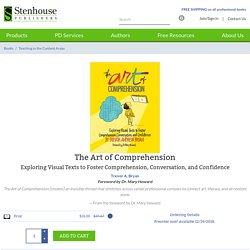
Take Singing to the English Class. Know Your Terms: Nonlinguistic Representation. Jerome Bruner's Theory of Development: Discovery Learning & Representation - Video & Lesson Transcript. Bruner - Learning Theory in Education. Bruner - Learning Theory in Education.

The Gradual Release Of Responsibility Model In 6 Simple Words. Three Lessons from Grant Wiggins 1 2. Using Playlists to Differentiate Instruction. OPINION: Advice about how to raise the high school graduation rate — from students themselves - The Hechinger Report. “Ask how we’re doing and mean it.
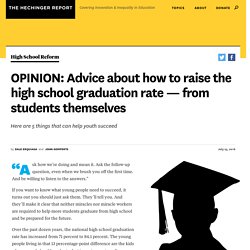
Ask the follow-up question, even when we brush you off the first time. And be willing to listen to the answers.” If you want to know what young people need to succeed, it turns out you should just ask them. They’ll tell you. National Center on Disability and Journalism. The style guide is intended for journalists, communication professionals and members of the general public who are seeking the appropriate and accurate language to use when writing or talking about people living with disabilities.

The guide covers general terms and words on physical disabilities, hearing and visual impairments, mental and cognitive disabilities and seizure disorders. Entries are listed in alphabetical order. Click on the index to the left to jump to entries that begin with that letter. Mind's Eye: A Pre-Reading Strategy. To Boost Higher-Order Thinking, Try Curation.
Gamify Reading for Maximum Student Engagement. There is always an ongoing debate in classrooms, particularly at the elementary level, as to the effectiveness of adding technology to early and more advanced reading programs.
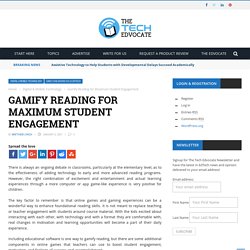
However, the right combination of excitement and entertainment and actual learning experiences through a more computer or app game-like experience is very positive for children. The key factor to remember is that online games and gaming experiences can be a wonderful way to enhance foundational reading skills. It is not meant to replace teaching or teacher engagement with students around course material.
A Step-by-Step Plan for Teaching Argumentative Writing. 7 Easy Ways to Support Student Writing in Any Content Area. The Elementary Good Work Toolkit. The Elementary Toolkit is a work in progress.

To access our most updated draft, click here! Despite the versatility of the Good Work Toolkit, one space to which it was not immediately adaptable was the elementary classroom. The Good Work Toolkit was initially designed with high school students in mind, and although older students and professionals were able to readily repurpose and use the materials, it was less accessible for a younger audience. At the annual Project Zero Summer Institutes, elementary school teachers frequently asked if we had materials for their students. Close Reading in a Secondary Classroom Reproducibles. Home - Credo InfoLit Modules - LibGuides at Miami University. Ohio Leadership Advisory Council.
* Recently Updated * This newly updated module explores various ways that educators create, adapt, adopt, and modify curriculum.

It addresses many relevant topics, including: The Future of Classical Music Is … Instagram? - 21CM. We classical musicians have changed a lot about our concerts.

More and more, we’re playing in nontraditional venues, we’re relaxing show etiquette, we’re developing programs that interact with audience members or respond to their needs. Classical Revolution Baltimore recently announced a show entitled “Classical Music For People With Short Attention Spans,” meant to accommodate, rather than correct, wayward listeners by presenting highlights of favorite pieces in under five minutes each.
The most recent Lowlands Festival in the Netherlands featured the premiere of the Smartphone Orchestra, in which cell phones were neither silenced nor tucked into the darkness, but rather incorporated into the fabric of the performance. Can we go further? Designing & Teaching Learning Goals & Objectives, Tips. Designing & Teaching Learning Goals & Objectives When designing a learning goal, one should first identify the type of knowledge the learning goal addresses.
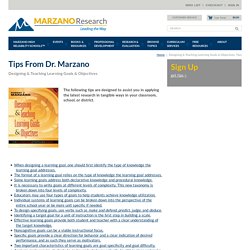
Generally, knowledge falls into two broad categories: (1) declarative knowledge and (2) procedural knowledge. Declarative knowledge could be defined as informational knowledge, whereas procedural knowledge is knowledge involving skills, strategies, and processes. For example, declarative knowledge generally pertains to vocabulary, facts, principles, and concepts.
Close Text Reading with Randall Gammiero and the Students of Mill Middle School. ARTSEDGE: ARTSEDGE Games. Ubdeducators - Transfer Demand Rubric. Transfer Demand Rubric In Chapter 3 of Understanding by Design, "Gaining Clarity on Our Goals," Wiggins and McTighe suggest the following rubric to "self-assess and peer review the design of any assessments purporting to involve true application with authentic challenges.
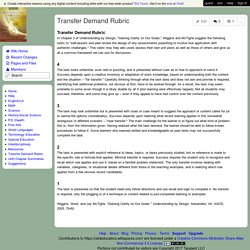
" This rubric may help wiki users assess their own unit plans as well as those of others and give us all a common framework we can use for discussion. The task looks unfamiliar, even odd or puzzling, and is presented without cues as to how to approach or solve it. Success depends upon a creative inventory or adaptation of one's knowledge, based on understanding both the content and the situation -- "far transfer. " Common Core in Action: 10 Visual Literacy Strategies. Do you wish your students could better understand and critique the images that saturate their waking life? That's the purpose of visual literacy (VL), to explicitly teach a collection of competencies that will help students think through, think about and think with pictures.
Standards Support Visual Literacy Instruction Visual literacy is a staple of 21st century skills, which state that learners must "demonstrate the ability to interpret, recognize, appreciate and understand information presented through visible actions, objects and symbols, natural or man-made. " Putting aside the imperative to teach students how to create meaningful images, the ability to read images is reflected in the following standards. Visual Thinking Strategies Overview of Aesthetic Development. In his 1997 article Thoughts on Visual Literacy, Philip Yenawine describes visual literacy as “…the ability to find meaning in imagery. It involves a set of skills ranging from simple identification (naming what one sees) to complex interpretation on contextual, metaphoric and philosophical levels. Many aspects of cognition are called upon, such as personal association, questioning, speculating, analyzing, fact-finding, and categorizing.
Objective understanding is the premise of much of this literacy, but subjective and affective aspects of knowing are equally important.” Eye-of-the-Beholder. Visual Thinking Strategies Research and Theory. Abigail Housen developed rigorous research methods based on her work with VTS over several decades, and informed by her studies over a wide range of settings and with diverse populations. This section introduces three of the primary data collection methods used in Abigail Housen’s research. The Aesthetic Development Interview (ADI) is a core tool used in her empirical research from which she derived her Stage Model of Aesthetic Development, and which continues to be used today to measure aesthetic stage and stage growth.
Both the Writing Sample and the Material Object Interview tools were used in subsequent research examining the impact of VTS and Aesthetic Development on critical thinking. Aesthetic Development Interview VTS's main data collection instrument is a non-directive interview, the Aesthetic Development Interview or ADI, that involves showing subjects a reproduction of a work of art and asking them to talk about it as though thinking out loud. Writing Samples. So you have a Twitter account. Now what? What Advice Would You Give a Student Teacher? Understanding by Design, Chapters 5-9. Understanding by Design, Chapters 1-4. Five Music Strategies for the ELA Classroom. In my experience as music educator, I can say that the connections between music and ELA are strong, organic, and easy to capitalize on with a few simple strategies. One of the concerns I usually hear in integrating the arts, particularly music, into the classroom is that the teacher lacks musical expertise.
I am here to share a few music strategies with you that require little to no musical expertise, per se, but rather a general understanding of musical concepts and elements. Art Critique in the Classroom - A Feedback Technique. Using Music And Rhythm To Develop Grammar. CAST Professional Learning udl top 10 learning goals. 12 Ways to Support English Learners in the Mainstream Classroom. MTO 21.4: Parsons, Dyslexia and Post-Secondary Aural Skills Instruction. Fairness isn’t making sure everyone gets the same thing. To Boost Higher-Order Thinking, Try Curation. Primary & Secondary Dyslexia. Romeo and Juliet. Romeo and Juliet in dance. Six of the best: pieces of classical music inspired by Shakespeare's Romeo and Juliet. 23 April 2016 is the 400th anniversary of the death of England’s most famous playwright. What If We Taught Argument in Every Class?Cult of Pedagogy.
Lyrics - 1,000+ ELT Videos. The Best Music Websites For Learning English. Check out my New York Times post for English Language Learners focuses on using music for language development and includes a student interactive, video, and teaching ideas. I use music a lot in my teaching of English Language Learners. 50 Incredibly Useful Links For Learning & Teaching The English Language. Teaching a new language to non-native speakers may be one of the most challenging educational jobs out there, so ELL teachers can use all of the help they can get!
Epic! - Books for Kids. Orbis Pictus Award for Outstanding Nonfiction for Children. Literacy and the arts lesson ideas. Collins Writing Program Introduction. What Makes the Collins Writing Program Unique? Core 6: Write to Learn. Tell it sell it strategy. How to Assess an Arts Integration Lesson. One of the many things I hear from teachers about attempting an Arts Integration lesson is “how and why should I assess the arts piece”? This is such a valid concern because many classroom teachers have never had any formal training in an artform, nor were they ever taught the pedagogy of teaching the arts in their educational programs.
GUIDE TO ARTS INTEGRATION CONNECTIONS. Why We Need to Move Away from SMART Goals and Towards New Forms of Classroom Assessment. ScarpelliD RAFT toolbox. Creating S.M.A.R.T. Goals — Top Achievement. Flush with Funding, Flocabulary Will Let Students Write Their Own Rhymes. Exercises. Free HTML5 Online Animation Maker, Banner Maker and Video Maker. Assessment selector tool. Find Your Marigold: The One Essential Rule for New Teachers. What Advice Would You Give a Student Teacher? STEAM Integration Unit: Joyful Noise Poems for 2 Voices. CREATING AN ARTS INTEGRATION LESSON. Effective Lesson Planning for the Secondary Choral Director - National Association for Music Education (NAfME) Motivation - Thoughts on Arting. Curriculum Mapping: Forming Essential Questions for Elementary Music Class - Music & Technology -MusTech.NetMusic & Technology -MusTech.Net.
Quest - Write text adventure games and interactive stories. Text-Based Games. Educator Innovator. Arts integration and steam toolkit. Peer Editing. Dichotomous Rubrics - From LtoJ Consulting Group. Six Traits Writing 5 Point Dichotomous Rubric Plus Graphs. Educational Leadership:Teaching for the 21st Century:Six Steps to Better Vocabulary Instruction. Six_step. Vocabulary Marzano Steps Descriptors. Which words to teach. Academic Vocabulary PowerPoint. Academic Vocabulary and the Arts. The Ultimate Common Core and Arts Resource-Education Closet. Arts literacy common vocabulary k5. Sight-Reading with your Middle Level Ensemble? Take a New Look at a Word Wall. - National Association for Music Education (NAfME) Vocabulary Activities, Vocabulary Games and Vocabulary Ideas. ♫ We ❤ Music @ HSES! ♫ 5 Fantastic, Fast, Formative Assessment Tools.
Search Lesson Plans. Video: Using Anchor Charts in the Classroom. What Are Anchor Charts? 'Barrelhouse Words: A Blues Dialect Dictionary' Book Excerpt. Self-Study English Grammar Quizzes (ESL, EFL) Story Starters: Multi-Genre Writing Prompts for Kids. Neural Pathways and Primary Music Education. Steps in Developing a Rubric. SIOP - Resources.